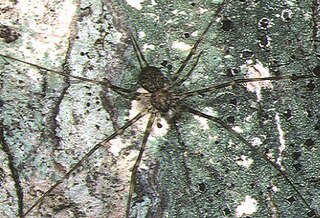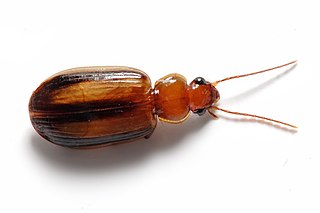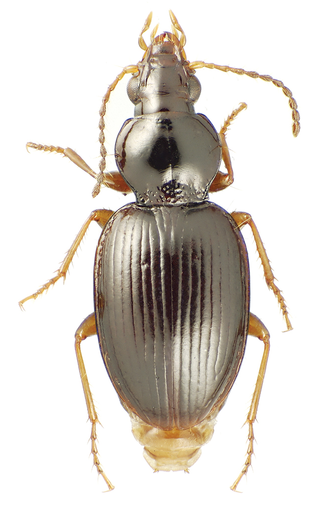
Ant spiders are members of the family Zodariidae. They are small to medium-sized eight-eyed spiders found in all tropical and subtropical regions of South America, Africa, Madagascar, Australia-New Guinea, New Zealand, Arabia and the Indian subcontinent. Most species are daytime hunters and live together with ants, mimicking their behavior and sometimes even their chemical traits. Although little is known about most zodariids, members of the genus Zodarion apparently feed only on ants; a number of other genera in the family are apparently also ant specialists.

Hersiliidae is a tropical and subtropical family of spiders first described by Tamerlan Thorell in 1869, which are commonly known as tree trunk spiders. They have two prominent spinnerets that are almost as long as their abdomen, earning them another nickname, the "two-tailed spiders". They range in size from 10 to 18 mm long. Rather than using a web that captures prey directly, they lay a light coating of threads over an area of tree bark and wait for an insect to stray onto the patch. When this happens, they encircle their spinnerets around their prey while casting silk on it. When the insect is immobilized, they can bite it through the shroud.

Prodidominae is a family of spider, sometimes called long-spinneret ground spiders. It was formerly regarded as a subfamily of Gnaphosidae, but was raised to a family in 2022.
Habronestes is an ant-eating spider genus that occurs only in Australia.

Amblytelus is a genus of ground beetle including 47 species distributed through southern Australia, including the Southwest and along the east coast up to North Queensland. It contains the following species:
Tama novaehollandiae or Tamopsis novaehollandiae are names used for an Australian spider species. However, the original type specimen has been lost, and it is not clear which, if any, of the many species of Tamopsis now recognized the name refers to, so it is treated as a nomen dubium. Tamopsis is placed in the family Hersiliidae.

Mecyclothorax is a genus of beetles that contains over 400 described species or subspecies, mostly from the Hawaiian Islands, and Tahiti and Moorea, French Polynesia. Additional radiations have evolved in Queensland, Australia, New Guinea and New Caledonia. The genus has been divided into five subgenera: Eucyclothorax Liebherr 2018 of Australia, Qecyclothorax Liebherr 2018 of Queensland, Australia, Meonochilus Liebherr & Marris, 2009 of New Zealand, Phacothorax Jeannel 1944 of New Caledonia, and the more widely distributed subgenus Mecyclothorax Sharp 1903 [in Australia, the Sundas, New Zealand, the Society Islands, and Hawaii]. The adelphotaxon to Mecyclothorax is hypothesized to consist of the genera associated with Amblytelus Blackburn, also distributed in Australia, and therefore the evolutionary history of Mecyclothorax commenced in Australia.

Notagonum is a genus of beetles in the family Carabidae, containing the following species:
Cryptocephalomorpha is a genus of beetles in the family Carabidae, containing the following species:
Dystrichothorax is a genus of beetles in the family Carabidae, containing the following species:

Tasmanitachoides is a genus of ground beetles in the family Carabidae, endemic to Australia. The beetles are very small, typically 1.5 to 3.0 mm. in length, and live in coarse sand or fine gravel along freshwater shorelines throughout Australia.

Tamopsis is a genus of tree trunk spiders that was first described by B. Baehr & M. Baehr in 1987. Like other members of the family, they may be called two-tailed spiders, referring to two elongated spinnerets. The name is derived from the genus Tama and the Ancient Greek ὄψις, meaning "resembling".

Ooperipatellus is a genus of Australian and New Zealand velvet worms in the Peripatopsidae family. Species in this genus are oviparous. Most species in this genus have 14 pairs of legs, but O. nanus has only 13 pairs, which is the minimum number found in the phylum Onychophora. Velvet worms in this genus are among the smallest known, with adults often only 10 to 20 millimeters long. Morphological and molecular data indicate that this genus is a monophyletic group.
Camptoscaphiella is a genus of spiders in the family Oonopidae. It was first described in 1934 by Caporiacco. As of 2017, it contains 18 Asian species.
Cavasteron is a genus of spiders in the family Zodariidae. It was first described in 2000 by Baehr & Jocqué. As of 2017, it contains 12 species, all from Australia.
Masasteron is a genus of spiders in the family Zodariidae. It was first described in 2004 by Baehr. As of 2017, it contains 21 Australian species.
Pentasteron is a genus of spiders in the family Zodariidae. It was first described in 2001 by Baehr & Jocqué. As of 2017, it contains 8 Australian species.
Spinasteron is a genus of spiders in the family Zodariidae. It was first described in 2003 by Baehr. As of 2017, it contains 19 Australian species.
Barbara Baehr is a German research scientist, entomologist, arachnologist, and spider taxonomist. She has described over 400 new spider species, mostly from Australia. She is originally from Pforzheim, Germany.








